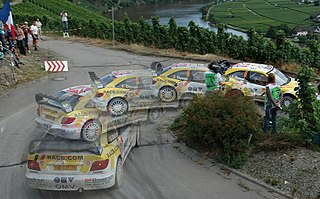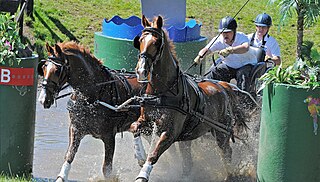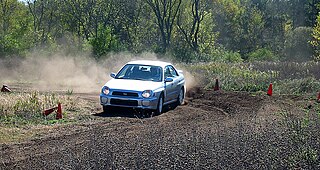Motorcycle sport is a broad field that encompasses all sporting aspects of motorcycling. The disciplines are not all races or timed-speed events, as several disciplines test a competitor's various riding skills.

The handbrake turn is a driving technique used to deliberately slide a car sideways, either for the purpose of quickly negotiating a very tight bend, or for turning around well within the vehicle's own turning diameter.
Motorsport(s) or motor sport(s) are sporting events, competitions and related activities that primarily involve the use of automobiles, motorcycles, motorboats and powered aircraft. For each of these vehicle types, the more specific terms automobile sport, motorcycle sport, power boating and air sports may be used commonly, or officially by organisers and governing bodies.

Autocross is a form of motorsport in which competitors are timed to complete a short course using automobiles on a dirt or grass surface, excepting where sealed surfaces are used in United States. Rules vary according to the governing or sanctioning body, such as the length of the course, the amount of permitted attempts, or whether competitors start the course individually at intervals or at the same time as others. In this latter form, Autocross differs from other forms of motor racing by using a system of heats or alternative timing methods for the classification rather than racing for position and declaring the first across the finish line as the winner.
Motorkhana is a low-cost form of motorsport, unique to Australia and New Zealand but similar to autotesting in the UK and Ireland and gymkhana in the US. It involves manoeuvring a car through tight tests as quickly as possible - one car at a time - on either dirt or bitumen surfaces. This usually requires sliding and spinning the car accurately while maintaining speed through the test course. Some reversing is usually included.

Rallycross is a form of sprint style automobile racing, held on a closed mixed-surface racing circuit, with modified production or specially built road cars, similar to the World Rally Cars. It is mainly popular in the Nordic countries, the Netherlands, Belgium, France and Great Britain. An inexpensive, entry level type of rallycross is the Swedish folkrace or its Norwegian counterpart, the so-called bilcross. The folkrace is most popular in Finland where it was founded back in the late 1960s. In Europe, rallycross can also refer to racing 1:8 scale off-road radio-controlled buggies.

Super GT is a sports car racing series that began in 1993. Launched as the Zen Nihon GT Senshuken (全日本GT選手権), generally referred to as the All Japan Grand Touring Car Championship (JGTC), the series was renamed to Super GT in 2005. It is the top level of sports car racing in Japan.

Autotesting involves a series of tests, generally around traffic cones, to measure precision driving skill.

Combined driving is an equestrian sport involving carriage driving. In this discipline, the driver sits on a vehicle drawn by a single horse, a pair or a team of four. The sport has three phases: dressage, cross-country marathon and obstacle cone driving — patterned after the mounted equestrian sport of eventing. It is one of the ten international equestrian sport horse disciplines recognized by the Fédération Équestre Internationale (FEI). Combined driving became an FEI discipline in 1970 when Prince Philip, Duke of Edinburgh, the then-president of FEI, produced the first rule book.

RallyCross, also known as RallyX, is a type of car competition in the United States and Canada, sanctioned by Sports Car Club of America (SCCA). It is a timed event that involves solo driving on grass or dirt and can be considered "autocross on the dirt." As with autocross, the emphasis is on driver skill and handling rather than absolute speed, with frequent corners generally keeping speeds below 60 mph (100 km/h). In many ways RallyCross is to rally racing as autocross is to road racing.
The International Sporting Code (ISC) is a set of rules applicable to all four-wheel motorsport as governed by the Fédération Internationale de l'Automobile (FIA). It was first implemented in 1926.
Rami Serry is an Egyptian racing driver.

Kenneth Paul Block was an American professional rally driver with the Hoonigan Racing Division, formerly known as the Monster World Rally Team. Block was also one of the co-founders of DC Shoes. He also competed in many action sports events, including skateboarding, snowboarding, and motocross.
The following is a glossary of terminology used in motorsport, along with explanations of their meanings.

Motorcycle gymkhana is a motorcycle time trial sport in which riders compete to manoeuvre in the shortest time through a paved course restricted by traffic cones or other obstacles. Motorcycle gymkhana is especially popular in Japan.

In the United States, autocross is an individual motorsport in which drivers compete to set the fastest time on a temporary course. It differs from autocross in the rest of the world as events are usually held on large paved areas, such as parking lots or airfields compared to grass or dirt surfaces used elsewhere. Courses consist of turns, offsets, and slaloms marked by traffic cones; new courses are typically created for each event. In the rest of the world these types of events are known as autotests, autoslaloms or gymkhanas.
A roadeo is a competitive driving event for motor vehicle drivers. Named as a portmanteau of "road" and "rodeo", these competitions have been held for a range of different vehicles since at least 1937. Typically, drivers compete to pass through a variety of obstacles in the smallest amount of time, although the competitions may include other components, such as a written test.
The 2018 F4 Japanese Championship season was the fourth season of the F4 Japanese Championship. It began on 7 April in Okayama and finished on 11 November on Twin Ring Motegi after seven double header rounds.

The Japan Automobile Federation is an automobile association based in Minato, Tokyo. Founded in 1963, the main purpose of the organization is to handle various businesses related to automobiles, and to protect the interests of owners and drivers in Japan. As of 2021, the organization has 19.9 million members. It is the only organization in Japan that is a member of the FIA.

Autoslalom is a form of motorsport that takes place on short, temporary courses marked out on areas of sealed-surfaces such as car parks or disused airport runways. Competitors are timed to complete the course, with penalties given for diverting from the route or for touching the course markers. Each competitor starts individually and speeds are kept low to emphasise safety and to require good vehicle control.













